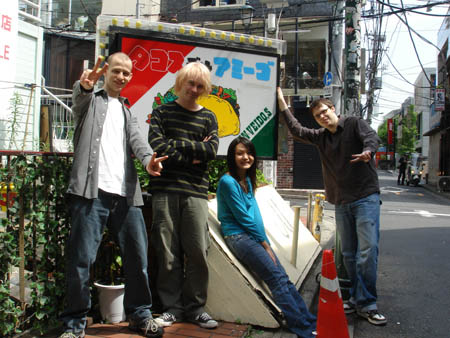There is a lot of excitement in the Japanese Metaverse these days.
I met some of the the most important Japanese metaverse companies at the Virtual Worlds Expo and Conference in New York City earlier this year. And, last week, I managed to catch up with Naoyoshi Shimaya, CEO of Metabirds, and Hiroshi Asaeda, CEO of Meltingdots. I also had a very interesting conversation with Ken Brady and Adam Johnson about their recently launched metaverse consulting company Genkii.
The picture opening this post is a self portrait by Yuki (Genkii’s CCO). See my interview with Ken and Adam later in this post, and my interviews with Metabirds here, and Meltingdots here.
Adam also clued me in to the Virtual Worlds Conference and Expo 2008, Tokyo May 28th to 30th. You can attend the conference in Second Life â„¢ (A registered Trademark of Linden Lab). Today, I had a little walkabout the conference site in Second Life (picture below).
Philip Rosedale, founder of Second Life â„¢ (A registered Trademark of Linden Lab) will give “his first and long awaited lecture in Japan.â€
Thanks to Genkii’s Adam Johnson for sending me all the updates on the conference! Also, Adam sent me some very interesting news about NTT’s recent investment in the ngi group (see below). This news is making 3Di and their OpenSim developers smile, I would guess!
Big news for the Open Source Metaverse in Japan!
NTTã¨ngiã€3Dインターãƒãƒƒãƒˆé–¢é€£äº‹æ¥ãªã©ã§æ¥å‹™ãƒ»è³‡æœ¬ææºã‚’発表
æ—¥ 本電信電話� �å¼ä¼šç¤¾ï¼ˆä»¥ä¸‹NTT)åŠã³åŒç¤¾ã®100%å会社ã§ã‚ã‚‹NTTインベストメント・パートナーズ� �å¼ä¼šç¤¾ï¼ˆä»¥ä¸‹NTT-IP)ã€ngi group� �å¼ä¼šç¤¾åŠã³åŒç¤¾ã®100%å会社ã§ã‚ã‚‹3Di� �å¼ä¼šç¤¾ã®4社ãŒã€3Dインターãƒãƒƒãƒˆé–¢é€£äº‹æ¥ã«é–¢ã™ã‚‹æ¥å‹™ææºã§æœ¬æ—¥åˆæ„ã—ãŸã¨ç™ºè¡¨ã—ãŸã€‚ã¾ãŸ NTTã¯ã“ã®ææºã®é–¢ä¿‚強化を目的ã¨ã—ã¦NTT-IPを通ã˜ã¦ngiåŠã³3Diã«å¯¾ã—ç·é¡ç´„16.3億円ã®å‡ºè³‡ã‚’実施ã™ã‚‹ã¨ã®ã“ã¨ã€‚
NTT, the largest telecommunication company in Japan will invest in the ngi group with a total of 1,630,000,000 yen. ngi group is the owner of 3Di so NTT is planning to work on metaverse business with their new NGN (next generation network) system (see Second Times).
I contacted 3Di who are very involved in OpenSim development and part of OpenSim core to try and find out more. But though “currently engaged in a lot of interesting discussion with other companies, and a lot of interesting projects” they are not commenting on this new round of funding. There was an English article in the Nikkei news, Thursday, May 8th, about the ngi/3Di/NTT deal, ” NTT To Take Stakes In ngi group Firms To Tap 3-D Virtual Space Tech:”
NTT will use the ngi group’s 3-D image processing technology to develop a system for managing virtual spaces on its fiber-optic based next-generation network (NGN). It will build such systems on behalf of companies that want to sell goods and host online advertising forums, among other businesses. It will begin receiving orders through such subsidiaries as NTT Communications Corp. as early as October
I asked Ken to comment on this news:
Ken Brady: As far as NTT taking a stake in ngi group and 3Di, I think we’ll have to wait and see what that means for the industry as a whole. NTT is huge, and they have a record of encouraging some really significant innovations. They could really be a driving force behind Japanese adoption of virtual worlds.
Tish Shute: Will this funding specifically get chaneled to any OpenSim projects or is that still another open question?
Ken Brady: I would bet some of it will go toward OpenSim projects, though I think it’s too early to say to what extent. Since NTT is taking an interest in 3Di, and since 3Di is so involved in OpenSim, I think there’s a pretty good chance that they are looking strongly in this direction.
Genkii:
“A Strategic consultancy for social media and virtual worlds.”
Above are Yuki’s portraits of Jeff Ames (CTO), Ken Brady (CEO), and Adam Johnson (COO) and a photo of the Genkii team in Tokyo.
Genkii is not only one of the coolest new companies on the planet, headed up by CEO, Ken Brady, formerly Director of International Strategies at Centric, a science fiction writer, and award winning film producer. But I think Genkii is one of the first Metaverse consulting companies in the world to put “a strong focus on leveraging Open Source platforms.”
While Japanese communities in Second Life are flourishing showing the some of the highest retention rates of anywhere in Second Life, Japan has become an important hub for OpenSim development.
The Open Metaverse enables a melding and reinvention of what has up to these point been divided realms – virtual worlds and the web. And, this company of metaverse “strategists” seems to be gearing up to make productive the fertile ground the first generation of metaverse evangelists has prepared.
As Ken points out virtual worlds are in an unusual and enviable position right now.
It’s really going to come down to what system gives users the experience they want. I think there is a lot of experimentation and head-scratching going on right now about this. In all phases of advertising, purchasing content, etc. Virtual worlds are in an unusual (and enviable, I’d argue) position because we are developing these things while still in the early stages of the industry, while industries like TV, print, movies, music are struggling with radical change.
I think what comes out of all this is a meshing of technologies. Hopefully we grab the good of what’s worked for the web and the good of what’s worked (so far) in virtual worlds and fuse them into a viable, scalable model. We need to create a system that allows people to create and play and work in virtual worlds as easily and as robustly as they do now on the web. That’s a pretty big order.
Also, that requires a huge melding of the minds. A lot of people from a lot of industries need to work together to make this happen.
Genkii already has a strong roster of strategic alliances including:
3Di, Centric, Metabirds, Synthespian Studios, Anvil Media, i-POP, Yosh, Fix8, Metaversatility, DeepThink Labs, and Syn Entertainment.
Interview with Ken Brady and Adam Johnson
Tish Shute: Ken how did you end up in Japan (Adam has told me his story before now he came to Japan to work for ngi!)
Ken Brady: My grandmother is Japanese and I’ve been coming back and forth here for about 5 years. My wife, Yuki, is Japanese/Taiwanese (she’s Genkii’s CCO), and we knew we’d like to live here at some point. While I was with Centric, I was back and forth helping them set up some operations in Asia, and moved when it worked out for everyone involved.
Tish Shute: It seems like Europe and Asia are blazing the trail with OpenSim. Is the US stuck in the dinosaur age re the Open Metaverse?
Ken Brady: OpenSim is growing quickly, there are more and more people (and companies) getting involved in its development, and it’s getting quite a bit of attention in VW media and blogs.
But I think it’s odd, isn’t it? When the web revolution really got its legs in 1995, the development was very US-centric, with other countries following. Now that we’re in the throes of a virtual world and 3D web revolution, it’s a real global undertaking. I don’t know if the US is exactly behind, but they’re certainly not holding all the cards in the game. What happens in Asia and Europe is certainly pushing the US these days.
Tish Shute: Yes you are right. It is not fair to say US is behind ‘cos everyone still has to take a hat off to Linden Lab!
Ken Brady: You’re absolutely right about recognizing LL as the icon they are. Especially in Asia, people always mention SL as the baseline on which every other upstart is measured. It’s all about whether something is a copy of Second Life, an alternative to Second Life, etc. Their name recognition is high.
Tish Shute: And yes SL asset development is spectacular!!! I am wondering if Linden Lab will make a move that could facilitate the rapid development of content in OpenSim. Then we would see a 3D revolution so much quicker, wouldn’t we?
Ken Brady: Agreed that asset development is key. OpenSim needs a robust system that will encourage interest in the platform. Active involvement by a large number of users is what’s going to get it really moving, of course. There’s something of a chicken and the egg dilemma there, right? Many people won’t use OpenSim until all the features are in place, while all the features may not be in place until more people use it.
Tish Shute: I am interested to pursue what your view on virtual economies is. Nao from Metabirds suggests that many new forms of virtual economies will emerge to promote asset development in the Open Metaverse but others seem to think virtual economies are a dead dog, and new models will drive asset developement. And, there are many that think Second Life be the heart of asset development in many prototypical virtual worlds if there work on interoperability with OpenSim proceeds? But what is your view on this very contested question?
Adam Johnson: The easiest route is just to plug in a system that’s already out there. Visa, or Paypal for example. There are also some pluggable game economy systems out there as well. Twofish comes to mind. The second way would be for Linden Lab to open up some sort of API to use their economy. OpenSim already has most of the inner workings in place for economy transactions. All that needs to be done is to customize it to your needs.
Ken Brady: Though I agree with Adam regarding plug-in economies (an easy route), I think there are so many possible models that could arise, depending on the nature of the virtual world in question. Closed systems offer some level of stability, such as with the L$, QQ coins, etc. But there will be certain situations where a virtual economy is not necessary to the development of the world. Barter systems can arise, a more open set of IP rules (like creative commons) could arise to allow more of a reputation-based economy.
Tish Shute: I know you are close to HiPiHi and they have a vision of creating a protected environment for a virtual economy but with some innovations on the Linden Lab model? They mentioned a virtual world ebay idea to me. Do you have thoughts on this idea?
Ken Brady: I don’t think that one system is right for every space. Unless we have all worlds becoming the same, operating on the same rules, with the same users, with the same goals for using each world. Of course, in that case, we’ll all create one virtual world, right?
I really think that reputation economies are viable, though, and what better place to prove the model than in a virtual world?
Tish Shute: Could you explain more about your idea of a reputaion model and what kind of economy that would work in?
Ken Brady: It was a science fiction idea that moved toward an economic model while no one was looking, I think. Both Jason Stoddard, Centric’s CEO and a fellow science fiction writer, and I are big propenents of this model. eBay is, to an extent, an example. In that case, your feedback (others’ satisfaction with your transactions) raises your standing in the community. As more people see your high rating, more people buy from you.
Tish Shute: Didn’t people game the reputation system in Second Life so much they had to take it out?
Ken Brady: Yes, people did that in SL. But it was a limited system, really. It was a popularity contest that didn’t truly mean anything. You didn’t get anything out of having a high ranking. With eBay, it’s self-correcting. Look at Digg or other systems that allow you to rate people up/down. Eventually, you know who to listen to/block. Or who to buy from/stay away from.
Adam Johnson: I think that it’s not well represented solely by a number. Something based on word of mouth probably holds more value.
Ken Brady: Exactly. In a world with no monetary system, though, reputation becomes the goal. The better your reputation, the higher your standing the community (whatever that may correspond to).
For this system to work as an economy, though, there has to be a way to actually get something out of your good reputation. Say, in SL, that land was given out based on reputation, and people with a certain rating got an island…it would make for a radically different environment. If there’s money coming in somewhere, it’s easier. If there is ad revenue, the higher your reputation, the higher the percentage of ad revenue passed on to you.
But this is all just conjecture. I guess I’m just saying that Nao from Metabirds is right: there are so many different models, and that there will be many concepts attempted.
Tish Shute: I realize from your work in Centric you are very familiar with all the social media plays. But I know many people are erked by the social media model of monetizing through advertising. They see advertising as taking over the internet! Will virtual worlds become Scobleized to survive in the open metaverse?
Ken Brady: I don’t actually think advertising is taking over the internet, nor will it take over virtual worlds. That’s been the argument from the beginning, but I think it’s a bit overstated. Ads are everywhere: TV print, movies, the room you’re in right now. They’re just more in your face online where you’re staring at a screen.
Adam Johnson: I’m sure there will be advertising free VWs, but they will cost you. If users want something that’s free, advertising will come into play more than likely. But, as computing power gets better, and the VW systems more efficient, and bandwith cheaper, it will become easier to support a VW with little money.
Ken Brady: I think Scoble offers an insight into the possibility of a reputation economy, so I think that will be one model.
Personally, I don’t have a problem with being paid to disseminate an idea I already have and support. Scoble hypes things he wants to hype, and that’s how advertising could change with that model of propagation. I don’t like the idea of people hocking products and ideas they don’t support, which is how it has worked with advertising in the past.
Adam Johnson: With reputation at least, if you hock something not good, you lose your reputation status. It is all balanced out and keeps people in check.
Ken Brady: I think having a two-tiered opt-out model (ads for a free experience; ad-free for a small fee) works sometimes. It may work in virtual worlds, but it’s not yet proven.
Tish Shute: Yes and there are two ends to this aren’t there? Because on the one hand much of the sophistication of the Web 2.0 revolution in terms of monetizing (and I agree Scoble is an example of that) has gone on apart from the development of virtual worlds up to this point. And, conversley the innovation of VWs has not really melded with the web so now we are at a turning point with OpenSim where these two directions collide and what will come out of this collision is…………?
Ken Brady: It’s really going to come down to what system gives users the experience they want. I think there is a lot of experimentation and head-scratching going on right now about this. In all phases of advertising, purchasing content, etc. Virtual worlds are in an unusual (and enviable, I’d argue) position because we are developing these things while still in the early stages of the industry, while industries like TV, print, movies, music are struggling with radical change.
I think what comes out of all this is a meshing of technologies. Hopefully we grab the good of what’s worked for the web and the good of what’s worked (so far) in virtual worlds and fuse them into a viable, scalable model. We need to create a system that allows people to create and play and work in virtual worlds as easily and as robustly as they do now on the web. That’s a pretty big order.
Also, that requires a huge melding of the minds. A lot of people from a lot of industries need to work together to make this happen.
Tish Shute: Yes but I take my hat off to Genkii, Tribal, Rex, Deep Think, HiPiHi, 3Di because none of you seem to be retreating in 2.5 D and flash plug ins or simply a model that plugs 3D into the web?
Ken Brady: I think those models are right for many people, but aren’t necessarily right for what we’re trying to accomplish overall. I think of most 2.5D/Flash virtual worlds as stepping stones. Sure, there are some great ideas and technologies that will come from them, but they are mostly grabbing a segment of the population that’s not ready (in hardware, broadband, or desire) to make the jump to more free-form 3D worlds. I firmly believe the 3D web is coming, but many times you have to take it in steps. And, really, that’s what Second Life, HiPiHi, OpenSim all are anyway. All steps toward something new.
Don’t get me wrong: I also think the 3D web will incorporate a lot of 2.5D/Flash technology, and that all that we learn from current and upcoming platforms will be integrated in those that come after. 3D worlds need to be easier, no download, more stable, etc. We’re just not there yet.
Tish Shute: And what about the intergration of mobile with immersive 3D?
Ken Brady: Mobile technology is absolutely central to any social technology here in Japan. Sometimes, I think people don’t realize how true that is, but think it’s an exaggeration. There are, I believe, now over 100 million mobile subscribers in Japan. And these are 3G phones. Coverage is awesome, and phone use is ubiquitous. Look at mixi, Japan’s largest social network. Most of its users update by mobile phone. Much more often than using a computer. Social media that doesn’t support mobile dies in Japan.
Tish Shute: But the integration of mobile and virtual worlds is not as easy is it – and I don’t mean technically I mean conceptually?
Ken Brady: It’s not easy. Conceptually, it’s a much different thing to be in a virtual world on a computer, keyboard and mouse at the ready, than using a mobile. I think that way of thinking stems from a western outlook. In the US, I think it will be hard to get people to log into a virtual world on their phones, even when the technology is available. In Japan, it wouldn’t be any more strange than sitting on the train watching TV on your phone, or writing a novel on your phone for others to read from their phones, or updating your mixi blog. These things happen constantly here already.
Tish Shute: Also as Genkii is the first consulting agency for VWs that I have seen that foregrounds open source (are there any others) could you tell me more about that?
Ken Brady: We don’t know if we’re the only consulting agency for VWs putting open Source upfront, but, if not, we’re one of the few. I know NMC has talked about its Open Virtual Worlds Project with Sun and I know others have mentioned open source worlds, but I’m not entirely sure where they stand on actual development and involvement.
Tish Shute: I should ask you articulate why you have directed you energy towards OpenSim and OpenSocial (but I am pretty sure I know the answer to that question) but many other people will not!
Ken Brady: I think you’ll see a lot more agencies talking about open source as soon as more clients are interested in it. Demand will drive it, as always. In our case, we believe that open source development is important to advancing these young technologies. We want to see virtual worlds and social media mature into the amazing technologies we know they can be.
OpenSim represents, we think, an opportunity to build a platform that will advance virtual world technology and the user experience. OpenSocial represents the same, albeit in a tangential industry.
Adam Johnson: We may have a bias towards OpenSim, but we are still agnostic in that effect. We are keeping our eye on the other projects such as Croquet, and Sun’s platform as well.
Ken Brady: We think this will be integral to advancing relevant industries, and we want to help where we can. It’s not about any one player or one platform. Adam is right. We’re platform agnostic, but we will recommend open source where it’s possible, and therefore applicable.
Adam Johnson: But I am in favor of all of the projects coming together to at least collaborate on knowledge, lessons learned, tips, etc.
I’m sure we are all going through similar problems, and are solving them over and over again needlessly.
Ken Brady: Agreed. I think the virtual worlds industry is awesome for one reason above many others: almost everyone I’ve met in the industry I like and want to collaborate with. I don’t feel competitive against most of them, because we’re all so early in this field. We all need to work together.
Adam Johnson: I think this year you will start to see some first steps in interoperability between the OpenSim projects. Within OpenSim, you will start to see all of the grids starting to interconnect with eachother, forming one large grid of grids. And from there, hopefully we can get some SL and OpenSim interconnect happening as well.
Tish Shute: So any involvement with enterprise solutions from Genkii?
Ken Brady: As far as enterprise worlds, we’ve certainly talked to some folks about it. I’ve discussed this in length with a lot of people in the film industry, especially. I think it’s a fascinating and exciting direction to go. 3D space is such a good collaborative environment and it’s being under-utilitzed. This summer I’ll be doing an interactive presentation for the Directors Guild of America on using virtual worlds for film production and collaboration. Having worked in the film industry myself and made movies, I feel it would be an outstanding use of the technology.
Adam Johnson: We definitely want to get involved there at some point. I know our partner Jeff Ames, who is also a core dev of OpenSim, and a major contributor to the OpenViewer project has some great ideas for dataviz.
Tish Shute: Then I have a big question for Ken re the science fiction to science moves that we may see soon in virtual worlds (the one i would most like to see is get 3D off a 2D screen!).
Ken Brady: I think there are an exciting number of science fiction concepts coming to life in virtual worlds already. I’ve gotten some grief from some of my fellow SF writers who ask why I’m wasting time in virtual worlds, seriously. I then show them some of the things that they wrote about or read about becoming real in the virtual space. Sometimes it scares them, sometimes excites them. It’s weird.
Certainly some of the most exciting are 3D devices. Who hasn’t been pining for full 3D? I still remember wearing a 3D helmet and playing with Dactyl Nightmare in the early 90s and I want to see integration of that sort of technology. We all know it will happen, but exactly when and which sort of system will be dominant is questionable. There are helmets, 180 degree screens, iGlasses, etc. Inobtrusive, wearable tech is really my personal choice. I look forward to augmented reality and my iGlasses. Input devices are also moving forward quickly. Mitch Kapor’s work in SL, Johnny Lee’s Wii hack, Surface, Keio University’s thought controller, and other similar technologies make me giddy.
Some of it is open source and some is not. I’m trying to get in to go play with as much as possible for an article I’m writing for Analog about virtual worlds. I’ll let you know when I find out!








June 9th, 2008 at 7:51 pm
Ken,
1. The SL reputation system that used to exist was self-correcting, too. It wasn’t as bad as everyone imagines. While some aspects of it were “gamed,” any system can be gamed. What happened is that when there *was* self-correction — negative votes — oldbies whose reputations had been established by long years of gaming the system were outraged and lobbied the Lindens to nerf the system. I don’t particularly care for reputation systems, but I have to say that the Linden system, if it had stuck to the idea of paying for making reputation points, and still provided some modest payout from the points, would work.
2. Re: “For this system to work as an economy, though, there has to be a way to actually get something out of your good reputation. Say, in SL, that land was given out based on reputation, and people with a certain rating got an island…it would make for a radically different environment. If there’s money coming in somewhere, it’s easier. If there is ad revenue, the higher your reputation, the higher the percentage of ad revenue passed on to you.”
This is a pretty awful idea, because it immediately leads to a FIC, a privileged group who mete out land and points according to their own lights. It’s not an open system. It isn’t self-correcting. And that “radically different environment” would rapidly become intolerable except for the in-group that benefited from it. Reputation systems are always rapidly controlled by those who code them, and those who have the time to work them. A lot of people don’t participate.
3. E-bay isn’t even the marvel people imagine, and there’s something very different about the very flat 2-D transaction of buy-sell with a listed product, and a “yes/no” as to whether the product was a) delivered on time b) in working order and as advertised and the far more complex transactions in a virtual world, i.e. “this hair creator made good hair and followed up to help me get it positioned right” or “this landlord provided orientation and customization and helped solve problems” etc. etc. It’s a far more robust and complex system, and a plus/minus, yes/no system can’t address it.
4. I don’t get this allergy to money, capitalist economies (Japan has one! works well!), marketplaces. Barter and communistic models tried over the ages have always failed, even if kept as small, tightly controlled hippie commune sorts of things. It’s not a model that can work in a huge decentralized widely distributed system with many different cultures and levels of people.
5. Visa and PayPal are not a solution, because they are flat, two-way transactions. You pay me behind the firewall on those sites — you don’t pay me inworld, in the round. One of the beauties of Second Life is that you have a microcurrency that is roughly on a free currency market (although Supply Linden constantly devalues it to keep it cheap) and people can buy and sell and trade with each other inworld spontaneously without signing up a lot of information (as they would have to do in Visa or PayPal), without having to meet certain levels of payment, and without high costs to the vendor. Lindens work really well. I don’t understand the aversion to them. Not having economies with buy-sell-trade interfaces in these new opensim worlds will make them exotic open-sourcey testtubes for geeks to gawk at, but not normal places for lots of people to benefit from and interact in.
As always, frankly, I’m annoyed, that under the guise of “new media technology” and “open source coding” and all the tekkie categories, the social and political issues of economy and politics are being discussed without the people who will have to participate in it, in ways that are of a distinct extremist viewpoint on the left. It opens up the question of whether you are trying to smuggle in leftist economic models by welding them into technology itself, so that people must helplessly obey their laws when the log on.
Ken, this stuff about Creative Commons is for the birds. Do *you* make your living with CC??? Do you know *anybody* who does?! I mean, seriously. It really becomes suspect for people who are consultants to companies that pay them normally in capitalist economies to then come up with these socialistic recipes for everyone else inside the world.
Prokofy